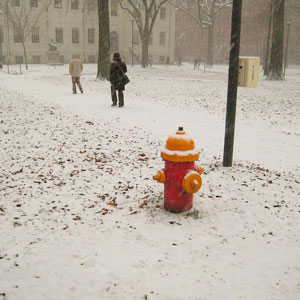Snowy Weather Might Mean More Indoor Pests
By Chris Williams on March 27, 2014.
 As I write this, eastern Massachusetts and eastern New Hampshire are expecting yet another major snowstorm…and it’s the end of March.
As I write this, eastern Massachusetts and eastern New Hampshire are expecting yet another major snowstorm…and it’s the end of March.
Whenever weather is an issue, entomologists, exterminators, and other pest experts always get asked, “How is this (pick one: very cold, very hot, too wet, too dry) weather going to affect (pick one: ticks, mosquitoes, chiggers, flies, wasps)?” Hoping, of course, to hear that the bugs will all be dead as a result and there won’t be any around to bother them soon. Experts are always quoted and they always seem to come up with a reason why whatever is happening with the weather will indeed impact insects—sometimes in a good way, sometimes in a bad way. No two experts agree.
Recently there has been a lot of media talk about the very cold weather nationally and how certain pests seem to have been knocked way back in numbers, literally frozen in place. (See our recent blog, “Did the Polar Vortex Kill Off the Stink Bugs?”) There have been plenty of news articles with similar titles like, “The Upside of the Bitter Cold: It Kills Bugs,” or “Cold Winter Killing Some NYC Pests,” or “Will the Harsh Winter Mean Fewer Mosquitoes?”
So I was surprised to find this heading, “Snow and Ice Now Could Mean Bugs Later” on Massachusetts Channel 22 Online News. Way to spin it, I thought; some entomologist is taking just the opposite tack. How is all this cold and ice setting us up for more bugs and “a bug-infested spring,” as claimed?
It might be a different approach, but turns out the article makes a good point. One of our problems with all this cold and snow is that ice dams can form on your roof. This causes water to leak into your home and this means you could have wet wood and moisture problems that you don’t even know about in your attic, or wall or ceiling voids. Lots of insects are attracted to damp wood and the mold that grows on damp wood. When temperatures creep up in spring and mold grows in those damp areas, you could find yourself dealing with anything from carpenter ants to fungus beetles.
Don’t Dam the Ice! Dry Out Those Damp Areas
The way to avoid this scenario is to not let ice dams form in the first place. See “Protecting Your Home in Extreme Cold.” If you find wet areas, dry them out ASAP with fans and/or a dehumidifier. It can take a long time to dry out an enclosed void space that has gotten wet, so in some cases you may need to open up the void to speed up the process.
So, yes it’s all true. This cold, snowy winter could mean more pests this spring, or it could mean fewer pests this spring. It all depends on your perspective and which expert you ask!
Photo credit: andrewmalone / Foter / CC BY